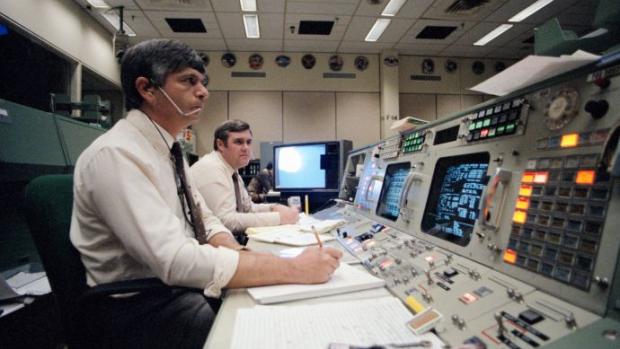Celebrating a Stellar Life and Career: Remembering Jay Greene

Jay Greene (foreground) studies data on monitors in the flight control room of the Johnson Space Center's Mission Control Center in 1986. Photo credit: NASA
To people who knew and loved him, Jay Greene’s ('64) appearances on the History Channel and in other media outlets were far from the most impressive thing about him. No screen could really capture his warmth, intelligence, humor, and just plain humanity.
While he was a beloved family man, friend, and co-worker to many, Jay, who passed away on October 8 of this year, was also a history-making figure who played a pivotal role in our nation’s space program.
A native of Brooklyn, Jay began his journey as an engineer at Tandon, back when the school was widely known as Poly. “Although his time as a student occurred well before I became chair, I take great pride in knowing that he got his start as an electrical engineer, right here in our department,” said Shivendra Panwar. “His career is a testament to the fact that electrical engineers can change the world.”
Dean Katepalli Sreenivasan points to Jay as a role model for young, aspiring engineers, whatever their course of study. “Isaac Newton once explained that he could see farther as a scientist only because he stood on the shoulders of giants,” the dean said. “I encourage all of our students to consider Jay among our own giants. Read about his life and his accomplishments at NASA, and be inspired to do similarly great things yourself.”
Jay’s engineering career at NASA began auspiciously: visiting the personnel office of the Manned Spacecraft Center in Houston for his initial interview in 1965, he spied astronaut John Glenn waiting in line just ahead of him.
“Isaac Newton once explained that he could see farther as a scientist only because he stood on the shoulders of giants. I encourage all of our students to consider Jay among our own giants. Read about his life and his accomplishments at NASA, and be inspired to do similarly great things yourself.”
~ Dean Katepalli Sreenivasan
His tenure at the agency coincided with a golden age of space exploration, and Jay never lost his appreciation for being a part of it — even during difficult times. Amidst the joy of being at Mission Control when Apollo 8 became the first manned spacecraft to leave Earth’s orbit, circle the moon, and return safely to Earth and overseeing the flight dynamics console during the descent of the lunar module in 1969, after Apollo 11 had carried Neil Armstrong and Buzz Aldrin to the Moon was the heartbreak of watching the space shuttle Challenger brake apart on January 28, 1986, just 73 seconds into its flight because of malfunctioning O-ring seals within a solid rocket booster.
Jay, who was serving as flight director on that ill-fated mission, which marked the first time NASA had lost a crew in flight, subsequently accepted a post as head of NASA's newly created safety division, and he later went on to take a series of other senior posts within the agency, including Deputy Associate Administrator for Exploration, Manager of the Space Shuttle Engineering Office, Deputy Manager for Technical Development on the International Space Station (ISS), and Chief Engineer at Johnson Space Center.
In whatever capacity he was working, Jay performed his duties with proficiency, technical talent, and a sense of deep responsibility.
“I knew Jay from the time I was selected as an Astronaut in July 1996,” fellow Tandon alum Charlie Camarda ('74) said. “Working for the Astronaut Office and assigned to the Structures and Mechanisms for Space Shuttle and the International Space Station (ISS) Programs, I encountered him as he took over the reins of the ISS program and was its technical lead through development and in-space assembly and operation. As the technical leader for ISS, he was largely responsible for its successful construction and operation. He worked tirelessly, using his technical expertise and persistence for excellence to ensure the safety of Astronaut crews for both the Shuttle and ISS Programs.” Camarda concluded, “Jay was a courageous man of the utmost integrity who would never back down when the safety of the crew and mission success were at stake and who always brought out the best in those who worked with him.”
While it’s common to say that someone has a “front-row seat to history,” Jay was on the stage itself. Consider that his career stretched from a time in which the entire NASA building he was working in had less computational capability than a modern smartphone to an era that has seen the development of the ISS, widely considered one of humankind’s greatest engineering achievements.
Jay’s CV includes a host of awards from NASA, including multiple Exceptional Service Medals, the Distinguished Service Medal, and the Silver Snoopy Award, as well as laurels from his alma mater (the most recent being the 2016 NYUAA Distinguished Alumnus Award). And thanks to his appearances in such documentaries as Failure Is Not an Option, Beyond the Moon, and NASA: Triumph and Tragedy, he is that rare engineer with the honor of a page on the Internet Movie Database.
Casual viewers unaware of his story might not realize it while watching those films, but the quietly competent man sitting behind the flight dynamics console was a towering figure in his field. More than 50 years after he left Brooklyn, Jay is remembered here, and we are proud to call him an alum.




